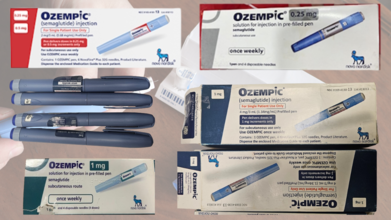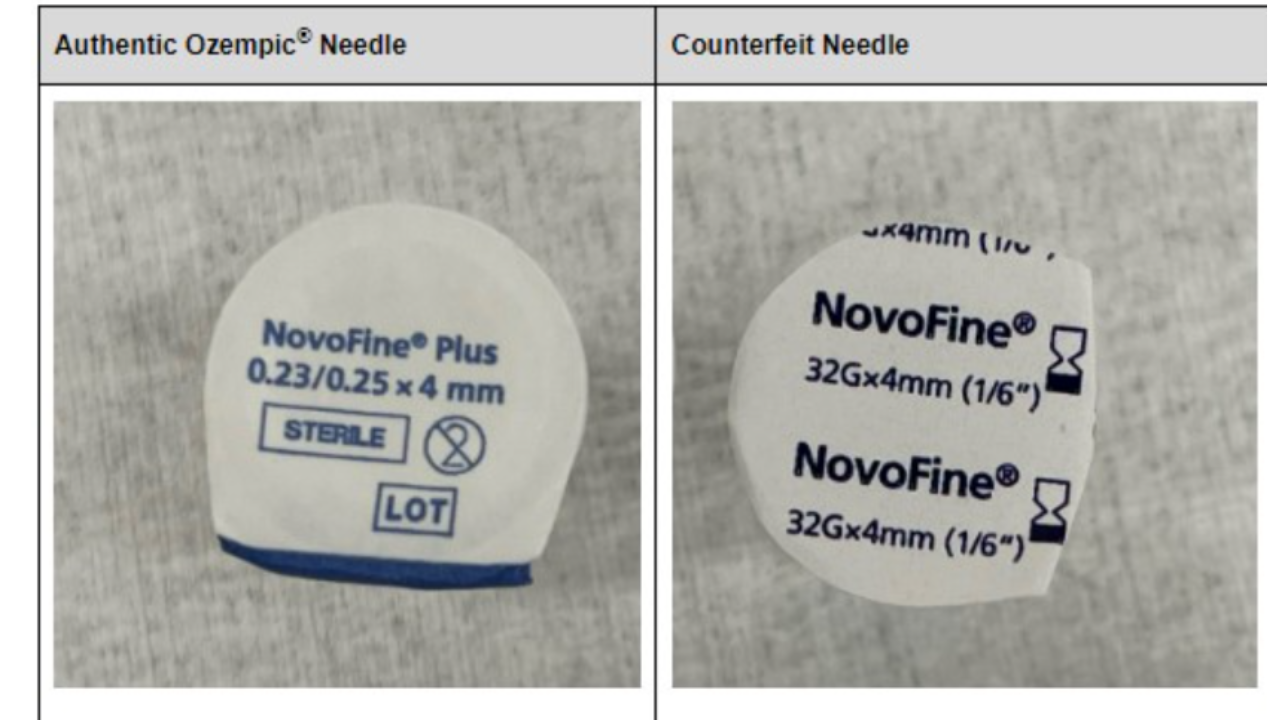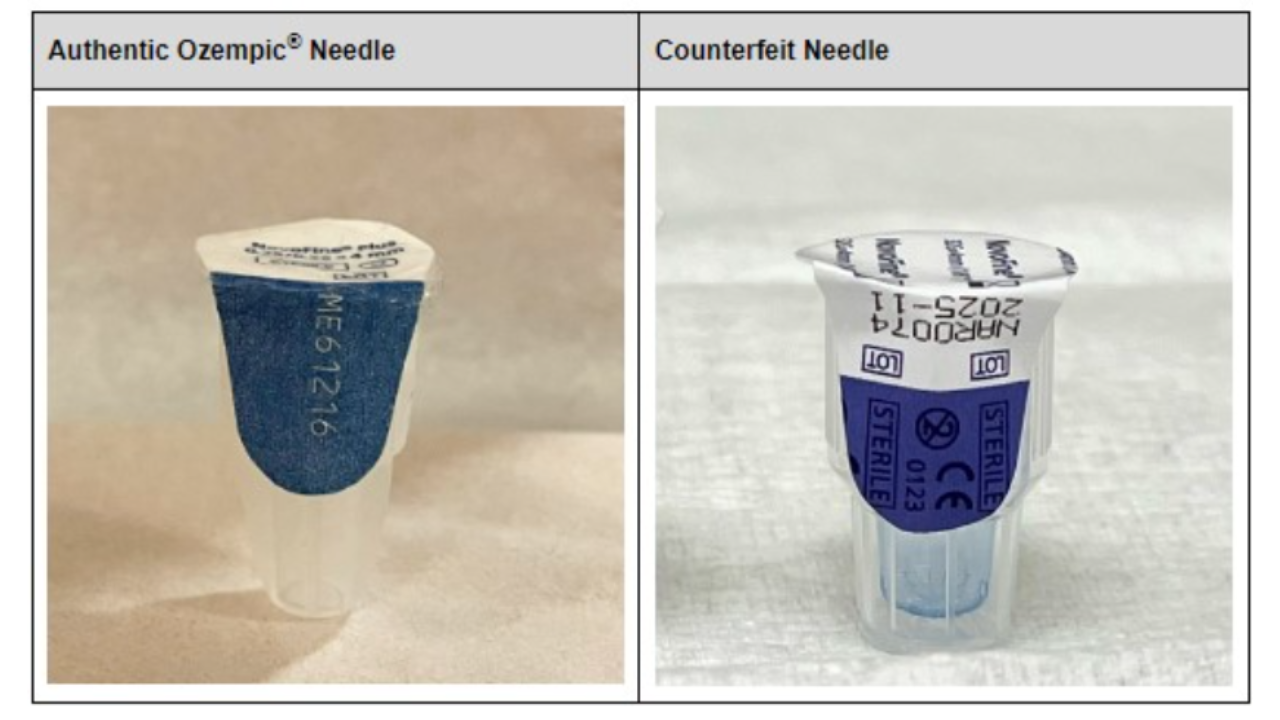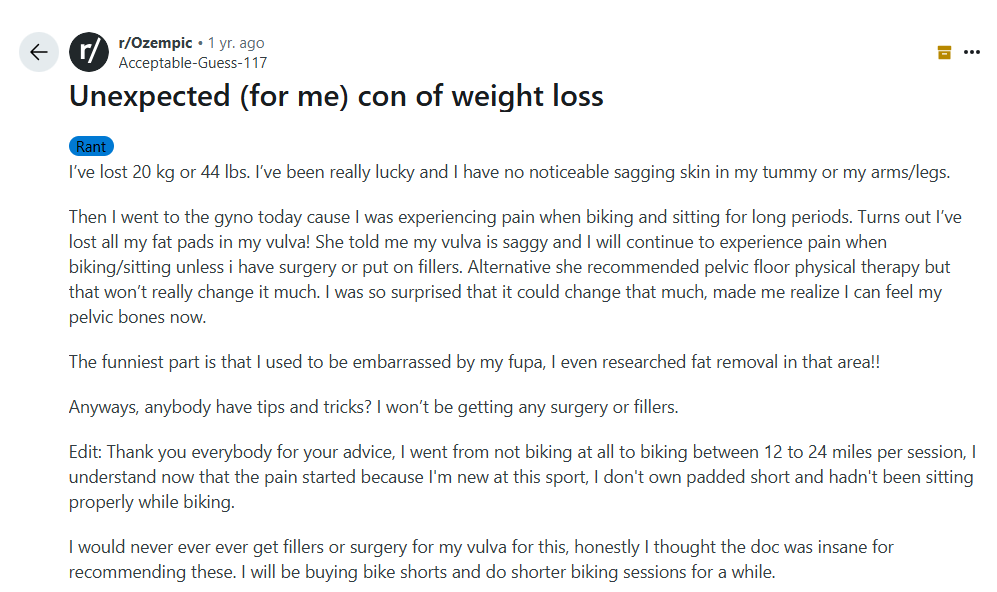- Health Conditions A-Z
- Health & Wellness
- Nutrition
- Fitness
- Health News
- Ayurveda
- Videos
- Medicine A-Z
- Parenting
- Web Stories
“I Lost Clumps Of Hair While Taking Ozempic', Woman Shares Shocking Side Effects Of Weight Loss Drug

Image Credits: Canva (representational only)
Ozempic has revolutionized weight loss and diabetes control, but with every passing day new evidence indicating to its impact on health needs closer examination. Although the new research doesn't necessarily establish that semaglutide is responsible for vision loss, it raises enough red flags to prompt further research and careful surveillance by patients and clinicians alike. As studies continue, individuals using these medications should remain aware of potential risks and take proactive steps to protect their vision. In 2023 alone, nearly 2% of the U.S. population was prescribed semaglutide, reflecting its widespread acceptance as an effective treatment.
But while shedding pounds is the goal, some users are facing an unexpected side effect—hair loss. Imagine going in the shower one day to catch clumps of hair in your hands. Shaky stuff, right? Hundreds of people who are taking the semaglutide drugs, such as Ozempic, are finding their hair doing the same, creating concern over what is actually happening in the body. Is the drug, or is extreme weight loss too soon the culprit?
When Desiree Rodriguez started taking a semaglutide drug to aid her weight loss journey, she expected the pounds to drop—not her hair. But around the 20-pound mark, she noticed something alarming: clumps of hair coming out in the shower, filling her hands with strands she never expected to lose.
If you're on a weight loss journey, you need to listen," she cautioned in a TikTok video that went viral. "You absolutely need to be eating right and taking vitamins.
Rodriguez is not isolated. Numerous people who use semaglutide-based drugs such as Ozempic and Wegovy have also reported excessive hair loss, a symptom that has become the subject of active online debate. Even the U.S. Food and Drug Administration (FDA) has monitored more than two dozen reports of hair changes among patients who use semaglutide. But why is this happening, and more crucially, can it be avoided?
Why Does Ozempic Cause Hair Loss?
Though one might initially suspect the drug itself, experts say the actual culprit is weight loss. Telogen effluvium—a temporary condition of hair loss associated with physical or emotional stress—is a typical outcome of substantial weight loss, such as that caused by semaglutide medications.
Hair experiences a natural cycle of rest, growth, and shedding. But when the body is subjected to severe stress—like a sudden drop in calorie intake—it takes priority for vital functions over hair production. This change pushes a significant number of hair follicles into the resting phase, resulting in excessive shedding some three months later after the stressor.
Dr. Rocio Salas-Whalen, a New York endocrinologist, clarified on TikTok, "For healthy hair growth, sufficient caloric intake should occur. When patients are put on stringent calorie-restrictive diets, this will affect their hair growth."
Role of Nutritional Deficiencies
Semaglutide acts to replicate the action of the GLP-1 hormone, a hormone that influences appetite and eating. While effective in weight reduction, it decreases hunger dramatically in some cases to the extent of not taking adequate necessary nutrients.
Protein, zinc, iron, vitamin D, and B-complex vitamins are all essential for promoting healthy hair growth. Deficiency in any one of these nutrients can worsen hair thinning and slow regrowth. Most patients on GLP-1 medication do not obtain their daily nutritional requirements, experts say, which leads to over-shedding.
Two Steps That Helped Slow the Shedding
For Rodriguez, the answer boiled down to two simple modifications: boosting her protein consumption and adding focused supplements to her daily plan.
Step 1: Boosting Protein Consumption
Protein is among the most significant nutrients for having healthy and strong hair. Hair is composed mostly of keratin, a protein that needs proper dietary intake to be synthesized effectively. Studies indicate that eating at least 100 grams of protein every day can help prevent hair loss due to quick weight loss.
Rodriguez felt the difference when she made a conscious decision to add more protein-rich foods to her diet. "Once I began adding 100+ grams of protein a day, I noticed the shedding slow down," she posted on TikTok.
For individuals taking semaglutide, adding lean meats, eggs, Greek yogurt, legumes, and plant-based proteins to their diets can maintain hair growth while they continue their weight loss regimen.
Step 2: Taking Hair-Supporting Supplements
In addition to supporting her hair's overall health, Rodriguez started taking Mary Ruth's Liquid Morning Multivitamin and using Minoxidil, which is a topical solution renowned for inducing hair growth.
Experts suggest certain vitamins and minerals that have been known to make hair stronger and lesser to shed, such as:
- Vitamin B complex (particularly biotin) to encourage keratin production
- Vitamin D to ensure follicle health
- Vitamin E for blood circulation on the scalp
- Iron and zinc to avoid shedding due to deficiency
- Magnesium and calcium to support hair follicle health
If on Ozempic or comparable meds, a high-quality multivitamin will supply nutrients that may have been stripped and help avoid loss of hair.
How Common Is Hair Loss With Semaglutide Drugs?
Although troubling, hair loss caused by Ozempic and other medications is fairly rare. During clinical trials involving Wegovy, a side effect experienced by only 3% of adults was hair loss, compared to 1% taking the placebo. In one study of tirzepatide (a weight loss medication marketed as Mounjaro), 5.7% of patients reported hair loss.
In comparison, 57% of patients who have bariatric surgery have severe hair shedding. Although these statistics indicate that hair loss is a potential outcome with semaglutide, it is by no means certain.
What Can You Do If You're Losing Hair on Ozempic?
If you're experiencing excessive shedding on semaglutide, there are a number of things you can do to slow or even reverse the process:
- Discuss with your physician the change in your dosage or the use of other nutritional supplements.
- Increase your protein level to a minimum of 100 grams daily.
- Take hair-beneficial vitamins such as biotin, vitamin D, iron, and zinc.
- Utilize topical therapies such as Minoxidil to promote hair regrowth.
- Avoid severe caloric restriction and eat a healthy diet to keep your body nutritionally well-provided.
The silver lining: Hair loss due to quick weight loss is often temporary. Most people notice regrowth after six months to a year as their body adapts to its new weight.
More Than Just Shrinking The Tumour: Experts Tell How Neoadjuvant Therapy Changes The Game In Breast Cancer Cases

Credits: Canva
Breast cancer has a strange way of being both familiar and frightening. Almost everyone knows someone who has battled it, and yet the details of treatment often sound like an alien language. According to the World Health Organisation, breast cancer is the most common cancer among women worldwide, with 2.3 million new cases in 2022 alone. Among these, about 15 to 20 per cent are HER2-positive, the type that is fast-moving, aggressive, and hard to ignore.
Increasingly, the doctors are turning to a strategy that feels a bit like hitting “pause” before the main act—neoadjuvant therapy.
What Makes HER2-Positive Breast Cancer Tricky
HER2 (human epidermal growth factor receptor 2) is a protein that helps cells grow. In HER2-positive breast cancer, the cells get an overdose of this protein. As a result, the cancer multiplies faster than usual and is often linked to poorer outcomes.
“HER2-positive breast cancer is an aggressive type,” explains Dr Mandeep Singh Malhotra, co-founder, Art Of Healing Cancer. “It is very important to give the right information to patients and their families for better outcomes. With the right treatment sequence, it is possible to offer better treatment to patients.”
What Is Neoadjuvant Therapy?
Neoadjuvant therapy (NT) is like a warm-up session but for cancer treatment. Instead of rushing into surgery to remove the tumour, doctors first administer chemotherapy and targeted drugs. The idea is to shrink the tumour, make surgery easier, and gather valuable intel on how the cancer responds.
“Nowadays, when we talk about HER2-positive breast cancer, we talk about targeted therapy and dual targeted therapy involving both trastuzumab and pertuzumab,” says Dr Malhotra. Both are monoclonal antibodies, meaning they are lab-made molecules designed to stick to specific parts of cancer cells. Together with chemotherapy, they not only shrink tumours but also improve surgical outcomes.
Why Doctors Like It
One of the superpowers of neoadjuvant therapy is its ability to act as a kind of crystal ball. By giving treatment before surgery, doctors can tell which patients are “responders” and which are not.
“As Dr Malhotra puts it, “Even at early stages, if we give NT and then operate, we are able to prognosticate. Responders have a better prognosis. Non-responders have poorer prognosis and a higher chance of the cancer coming back.”
This ability to sort patients into risk categories allows doctors to tailor follow-up care more precisely. For example, non-responders may be put on more aggressive treatments, offered newer diagnostic tests like liquid biopsy, or monitored more closely.
The Big Advantage Over Surgery-First
Surgery-first and neoadjuvant-first have similar survival data, but the latter provides an extra layer of information.
“If we do upfront surgery in these patients, we lose the chance of prognostication,” says Dr Malhotra. “Secondly, even if we do the upfront surgery, we will still have to give chemo with targeted therapy after surgery. So the treatment does not change; the sequence changes. And with neoadjuvant therapy, we get the added benefit of knowing who is high risk and who is low risk.”
In other words, neoadjuvant therapy is not just about shrinking tumours; it is about outsmarting them.
What Patients Need to Keep in Mind
For patients, all of this can feel overwhelming. Surgery often seems like the most direct way to “get rid” of cancer, so the idea of delaying it can cause anxiety. But Dr Malhotra reassures patients that this approach is carefully designed.
“Even in very early-stage breast cancer, with a less than 1 cm tumour, I will not go for surgery first,” he says. “I will first give targeted chemotherapy. The reason is I see a lot of patients who have already had surgery and then are given the option of dual therapy. They are confused and afraid that the cancer will come back if they cannot afford either trastuzumab or pertuzumab.”
Interestingly, cost can also play a role. If patients achieve a complete response, meaning no invasive cancer remains after neoadjuvant therapy, sometimes treatment can be stopped earlier, sparing both physical and financial strain. “We lose this opportunity if surgery is opted for first,” Dr Malhotra adds.
The Future of HER2-Positive Breast Cancer Treatment
The shift towards neoadjuvant therapy represents a significant change in how doctors approach HER2-positive breast cancer. Instead of rushing in with surgery, the modern strategy is more like a chess game, carefully setting up each move to give patients the best possible outcome.
By combining chemotherapy with targeted drugs like trastuzumab and pertuzumab before surgery, doctors can shrink tumours, assess risk, personalise treatment, and often improve long-term survival.
Breast cancer treatment has always been a mix of science, strategy, and courage. Neoadjuvant therapy, especially in HER2-positive cases, is proving to be more than just a pre-surgery step. It is a game-changer, giving both patients and doctors a crucial edge in the fight.
As Dr Malhotra puts it, “Neoadjuvant therapy is not an inferior modality. With current data, we feel it is a superior one.”
How To Identify A Counterfeit Ozempic? Look For These Signs, Details Inside

Credits: FDA, TGA, Securing Industry
Recently, an Iowa-based pharma company is dragged in an Ozempic lawsuit, reason? For selling counterfeit Ozempic.
What Is Ozempic?
Ozempic is a popular drug used for diabetes and weight-loss. Its official website notes that a medicine prescribed for people with type 2 diabetes and it comes in injection of .5mg, 1mg, or 2mg. It is injectable along with diet and exercise to improve blood sugar in people with type 2 diabetes.
The website also notes that it is the "first and only medicine in its class (GLP-1) proven to help lower the risk of worsening kidney diseases, kidney failure, and death due to cardiovascular disease in adults who also have chronic kidney disease".
What Happens When You Consume Counterfeit Ozempic?
The presence of fake Ozempic in the market is alarming. They are sold in lower prices, and could cause serious dangers to your life. One of the reasons being that these counterfeit Ozempic drugs may not have undergone the rigorous safety and efficacy testing that genuine medications do.
As per the Shapiro Legal Group, in 2023, incidents involving counterfeit Ozempic led to serious health emergencies in the United States.
ALSO READ: Iowa-based Pharmacy Faces Charges For Selling Counterfeit Ozempic
Three individuals experienced dangerously low blood sugar levels, after using the Ozempic pen. The pen instead contained insulin glargine, a medication used for long-acting blood sugar control in patients with diabetes. As per America's Poison Control Centers, all three of these cases were reported by the same regional poison control center, which meant that there might be a concentrated source of counterfeit Ozempic.
The Health Risks Counterfeit Ozempic Puts You At
Hypoglycemic Shock
This happens when your blood sugar levels drop dangerously low, and leads to confusion, trembling, heart palpitations, and sweating. Counterfeit Ozempic containing insulin instead of semaglutide can induce this condition unexpectedly in non-diabetics.
Coma
It is a deep state of unconsciousness, which can be triggered by severe hypoglycemia.
Infections
This can happen if you use non-sterile counterfeit Ozempic injections, which can introduce bacteria into the body. The signs could be redness, swelling, pain, itching, and pus at the injection site.
Seizures
This can happen when your counterfeit Ozempic contains insulin. As a result, it your blood sugar can drop and lead to uncontrollable jerking movements, loss of consciousness, and confusion.
How To Identify Counterfeit Ozempic?

The World Health Organization (WHO) has identified that counterfeit Ozempic have few features that consumers must be vary about. These include:
- Lot Number and Serial Number
- Pen's Scale
- Label Quality
- Spelling Mistakes
How To Check Lot Number And Serial Number For Fake Ozempic?

Novo Nordisk, a global health company in its press release noted that Ozempic box that has a lot number PAR0362, and serial number that begins with the first eight digits: 51746517 are not authentic. Novo Nordisk has asked people to report to Food and Drug Administration (FDA) in case they come across counterfeit Ozempic.
How To Check Pen's Scale For Fake Ozempic?

The WHO notes that falsified Ozempic pens may have a scale extending out from the pen when settling the dose. Therapeutic Goods Administration (TGA), under the Department of Health, Disability and Ageing, Australia also provides photos of extended pen scale on its website.
How To Check The Label Quality For Fake Ozempic?

FDA has provided photo evidence for consumers to differentiate between a fake and an authentic Ozempic needle, by looking at its label and packaging.
What To Look For?

In Genuine Needle: The paper tab on the needle is imprinted with the needle lot number
In Counterfeit Needle: The paper on the needle is imprinted with the Ozempic product carton lot number
In Genuine Needle: The blue area on the paper tab only contains the lot number and no other text, while the inner needle cover is transparent
In Counterfeit Needle: The blue area on the paper tab has texts written on it and the inner needle cover has a blue transparent color
In Genuine Needle: The paper tab states NovoFine Plus
In Counterfeit Needle: The paper tab states NovoFine
‘Ozempic Vulva’: The Bizarre Side Effect Affecting Women’s Health

Credits: Canva
GLP-1 medications, including the popular brand Ozempic, have made headlines for their dramatic weight loss results. Initially created to treat type 2 diabetes, the medications were a favorite among those wanting to lose weight due to their ability to control hunger. Semaglutide, the active drug found in Ozempic, makes consumers full for extended periods, resulting in significant weight loss in the body. However, with increasing popularity comes an uptick in reports of unusual side effects—some of which are leaving women shocked and bewildered.
Among the most surprising and strange side effects making the rounds among users is what has been colloquially referred to as "Ozempic vulva." The condition involves a reduction of fat in the labia majora, a sagging appearance, pain during routine activities, and alteration of sexual anatomy aesthetics. Although sagging skin and loss of elasticity have long been linked to weight loss, particularly if it occurs rapidly, this particular side effect has only recently emerged.
A Reddit poster posted a first-hand account of experiencing the results for herself. Losing 44 pounds, she at first was jubilant about the outcome. "I've been extremely fortunate and I don't have any sagging skin in my belly or arms/legs that I can notice," she described. But the biggest shock was when she went for a gynecologist appointment. "Turns out I've lost all my fat pads in my vulva! She informed me my vulva is droopy and I will keep on having pain when cycling/sitting unless I undergo surgery or wear fillers," the user posted.
The Redditor also revealed that pelvic floor physical therapy was provided as a substitute for cosmetic intervention, although it would not fully reverse the deflation. Her case highlights the need to be aware of how sudden weight loss, especially from medications such as GLP-1s, can impact lesser-known parts of the body.

Medically, the vulva comprises external female genitalia, mostly the labia minora and labia majora, that act as cushioning protection. Fat loss in this region may cause a greater prominence of the pelvic bones, decrease in cushioning, and pain during exercises like cycling, running, or sitting for extended periods.
What is 'Ozempic Vulva'?
The vulva is the external female genitalia, especially the labia majora covering the inner structures. Redditors and users of internet forums have described decreased fat pads in this region after precipitous weight loss caused by GLP-1 medication. One Redditor summed up her experience thus: after losing 20 kg (44 pounds), she developed pain when she cycled or sat for long hours. A gynecologist described losing much of the natural padding around her vulva, leading to a sagging sensation and discomfort during exercise.
This trend, affectionately but aptly called "Ozempop vulva," highlights a singular and seldom-talked-about side effect of weight loss caused by medications. For most women, it's not just aesthetic; it impacts daily comfort, sex, and self-esteem.
Cosmetic treatments have evolved as a result of this trend. "Labia puffing" is an increasingly sought-after procedure for women who experience vulvar deflation. This treatment either involves the use of dermal fillers or fat transfer to add volume to the labia majora, evening out the texture and alleviating discomfort. Though effective, it is quite expensive, between $2,600 and $6,500 in America.
Healthcare professionals are urging caution. Novo Nordisk, the drug maker of Ozempic, reassured the public that patient safety is of utmost priority and assured that the medicines are to be used only for approved use in a medical setting. They also urge reporting side effects to healthcare professionals or regulatory bodies. "Treatment decisions should be made together with a healthcare provider who can evaluate the appropriateness of using a GLP-1 based on assessment of a patient's individual medical profile," said the company.
The larger context of extreme weight loss makes visible the far-reaching consequences GLP-1 drugs can have. Patients experience a range of side effects, from gastrointestinal distress to loose skin, facial fat redistribution, and effects on sexual anatomy and desire. While the physical changes are something to be admired, these effects are a reminder that extreme weight loss is not risk-free.
Incidentally, online discussions of "Ozempic vulva" have become widespread in private online forums and social media sites. Users freely exchange experiences, coping mechanisms, and aesthetic issues. Many recommend practical measures like padded bike shorts or briefer periods of exercise to alleviate discomfort. Others discuss surgical or nonsurgical treatments, although opinions are highly diverse on whether such a procedure would be desirable or required.
Medical professionals emphasize the need for integrated treatment. Sudden loss of weight must be watched over by medical professionals who can advise on likely risks to both general health and particular aspects such as the vulva. Preservation of muscle tone, padding, and elasticity of skin is essential to avoid long-term complications. For women suffering from discomfort, focused physical therapy, proper protective equipment during exercise, and well-informed consideration of cosmetic interventions may all be part of a successful management plan.
Finally, "Ozempic vulva" highlights an increasing trend on the intersection of weight-loss medication and women's health. While the drug has transformed weight control for millions of people, its unintended side effects serve as a reminder that there are risks associated with every medical intervention and that they need to be closely monitored. Education, research, and transparency with healthcare professionals are critical towards preventing such unintended outcomes.
As GLP-1 drugs become more mainstream, patients and providers alike need to be watchful. New side effects such as "Ozempic vulva" demonstrate the importance of full education on the entire range of possible changes wrought by sudden weight loss. Meanwhile, women dealing with these effects are complying with both medical advice and home remedies, being resilient in the face of an odd but increasingly prevalent health issue.
© 2024 Bennett, Coleman & Company Limited



